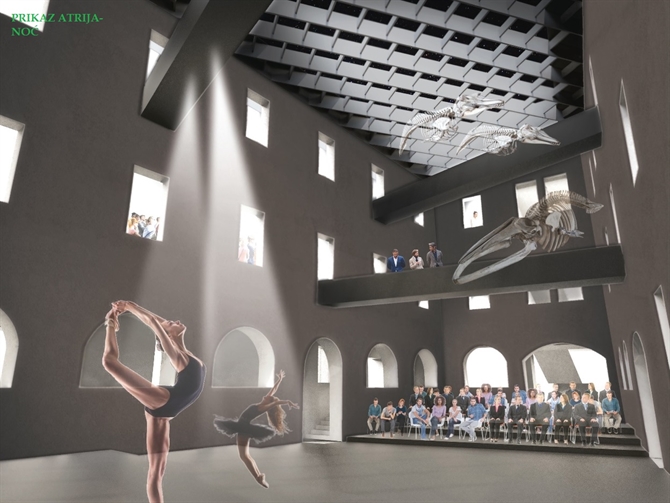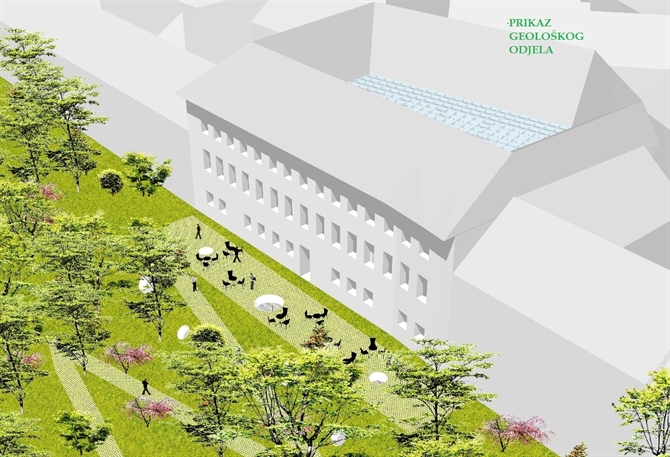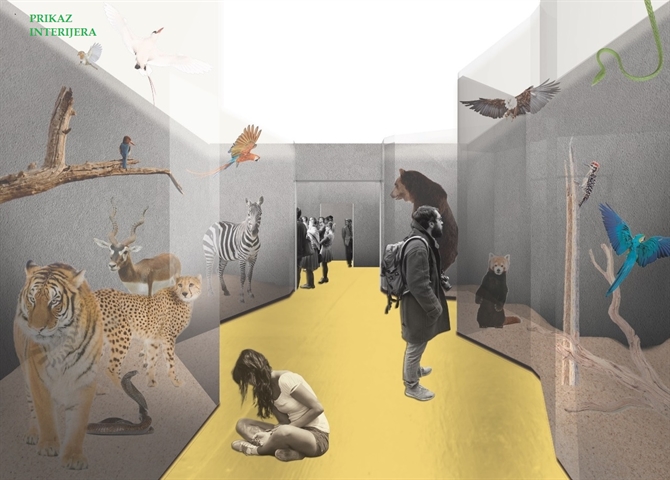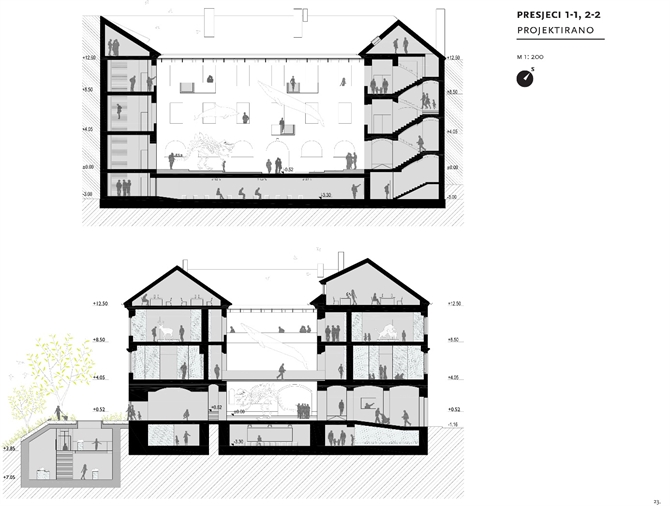New Croatian Natural History Museum

Funds allocated by the Ministry of Regional Development and EU Funds to the Croatian Natural History Museum and the City of Zagreb for the New Croatian Natural History Museum:
The project proposal “Culture, science, and education in the function of economic development – the new Croatian Natural History Museum" of the partner institutions of the Croatian Natural History Museum and the City of Zagreb was granted non-refundable funds of the Ministry of Regional Development and EU Funds in the amount of HRK 3,734,000.00.
Following the above, the Croatian Natural History Museum is starting the with the first phase, i.e. with the reconstruction of the building and the new permanent display of the Museum. The entire project documentation has to be made, and it consists of:
a) preparation of a feasibility study, analysis of costs and benefits, project application of group B activities,
b) the main and implementation project with geotechnical and geomechanical works and the permanent display project,
c) marketing plan,
d) communication strategy,
e) promotion and presentation of the project,
f) project management.
This is the start of an investment worth over HRK 70 million, which includes a series of new activities – with a representative and modern new permanent display, five certified laboratories, a new souvenir shop, a multimedia hall, and a cafeteria, all with the relocation of the Museum's depot.
Thus, the new Croatian Natural History Museum, after a complete reconstruction and 170 years of care and presentation of natural history in an inadequate space, will become a representative natural history center and a museum of the 21st century, as the City of Zagreb and the Republic of Croatia deserve.
Project description:
The goal of the project “Culture, science, and education in the function of economic development – the new Croatian Natural History Museum” is to strengthen the capacities of the Croatian Natural History Museum by renovating and equipping the Amadeo Palace, thus contributing to the development of tourism, economic, scientific, educational, and cultural activities.
After the implementation of the project, an increase in the number of visitors, improved visitor satisfaction, improvement of scientific activities through certified laboratories, improved activites in the field of conservation, and the presentation of Croatian cultural heritage are expected. Furthermore, an increase in the number of new employees and an increase in tourist expenditures for cultural services are expected.
To conclude, all project activities and project objectives are in accordance with the objectives of the priority axis 6 – Environmental protection and sustainability of resources, and of the investment priority 6c Conserving, protecting, promoting and developing natural and cultural heritage, and with the specific objective 6c1 – Increasing employment and tourist expenditure through enhancing cultural heritage, specified in the The Operational Programme 'Competitiveness and Cohesion' for the period 2014-2020. Namely, one of the goals of the project is to restore and preserve cultural heritage (Palace Amadeo) and increase its economic value by introducing new cultural and educational content. This will increase the number of visitors and contribute to the development of cultural tourism in the Upper Town. Moreover, with additional space and new equipment, the plan is to strengthen scientific research activities for the needs of the economy, thereby contributing to employment and economic growth.
Specific goals shall be achieved:
The goal of the project “Culture, science, and education in the function of economic development – the new Croatian Natural History Museum” is to strengthen the capacities of the Croatian Natural History Museum by renovating and equipping the Amadeo Palace, thus contributing to the development of tourism, economic, scientific, educational, and cultural activities.
After the implementation of the project, an increase in the number of visitors, improved visitor satisfaction, improvement of scientific activities through certified laboratories, improved activites in the field of conservation, and the presentation of Croatian cultural heritage are expected. Furthermore, an increase in the number of new employees and an increase in tourist expenditures for cultural services are expected.
To conclude, all project activities and project objectives are in accordance with the objectives of the priority axis 6 – Environmental protection and sustainability of resources, and of the investment priority 6c Conserving, protecting, promoting and developing natural and cultural heritage, and with the specific objective 6c1 – Increasing employment and tourist expenditure through enhancing cultural heritage, specified in the The Operational Programme 'Competitiveness and Cohesion' for the period 2014-2020. Namely, one of the goals of the project is to restore and preserve cultural heritage (Palace Amadeo) and increase its economic value by introducing new cultural and educational content. This will increase the number of visitors and contribute to the development of cultural tourism in the Upper Town. Moreover, with additional space and new equipment, the plan is to strengthen scientific research activities for the needs of the economy, thereby contributing to employment and economic growth.
Specific goals shall be achieved:
a) by restoring and reconstructing cultural heritage monuments
- complete reconstruction of the Amadeo Palace (premises, installations, internal and external enclosure), extension of the building’s glass annex in the Tuškanac Forest Park, equipping of the renovated building with furniture and modern presentation multimedia equipment, relocation of the Museum’s depot to another location, and the introduction of a new permanent display.
- complete reconstruction of the Amadeo Palace (premises, installations, internal and external enclosure), extension of the building’s glass annex in the Tuškanac Forest Park, equipping of the renovated building with furniture and modern presentation multimedia equipment, relocation of the Museum’s depot to another location, and the introduction of a new permanent display.
b) after infrastructural renovation and the introduction of new content
(a catering facility, a creative workshop for children, availability of a larger number of materials in permanent display, displays of large exhibits, acquisition of new materials, a multimedia hall, etc.), intensive promotion is expected in Croatia and abroad. A new website will be created, the Museum will be promoted on social networks, cooperation will be established with all local tourist boards in Croatia and travel agencies, and promotional printed materials will be created, as well as multimedia content, thereby raising the public awareness of cultural heritage through promoting it, all with the aim of increasing visibility. The aforementioned activities will include the promotion of cultural heritage destinations through the only natural history museum in the City of Zagreb, the largest natural history museum in Croatia, and the largest heritage institution in the country in terms of holdings.
(a catering facility, a creative workshop for children, availability of a larger number of materials in permanent display, displays of large exhibits, acquisition of new materials, a multimedia hall, etc.), intensive promotion is expected in Croatia and abroad. A new website will be created, the Museum will be promoted on social networks, cooperation will be established with all local tourist boards in Croatia and travel agencies, and promotional printed materials will be created, as well as multimedia content, thereby raising the public awareness of cultural heritage through promoting it, all with the aim of increasing visibility. The aforementioned activities will include the promotion of cultural heritage destinations through the only natural history museum in the City of Zagreb, the largest natural history museum in Croatia, and the largest heritage institution in the country in terms of holdings.
c) a greater number of employees will be employed,
who are related to the tourism sector.
who are related to the tourism sector.
d) likewise, through the new souvenir shop, investment will be made in the development of new tourist products related to cultural heritage,
and close cooperation with local crafts, artisans, and small businesses will be accomplished in the process of designing and producing heritage souvenirs.
and close cooperation with local crafts, artisans, and small businesses will be accomplished in the process of designing and producing heritage souvenirs.
e) the cultural heritage management system will be improved by creating management plans for the purpose of increasing employment and tourist expenditures
through the improvement of cultural heritage, which will be achieved by the activities proposed above.
through the improvement of cultural heritage, which will be achieved by the activities proposed above.
Details of the activities through which goals are achieved:
By renovating and equipping the Amadeo Palace, Demetrova 1, Zagreb, entered as an “Immovable cultural property – individual” under the goods designation Z-619 in the Register of Cultural Property of the Republic of Croatia, the capacities of the Croatian Natural History Museum will be strenghtened, which will contribute to the development of economic, scientific, educational, and cultural activities.
The general and specific goals of the Integrated Project are intended to be achieved through the following activities:
Component/Activity 1: Reconstruction of the Amadeo Palace - investment category Heritage Culture
a) Demolition and works on the existing building. The reconstruction of the palace includes the complete renovation of the building and installations, as well as the introduction of new walls and installations that do not currently exist in the building.b) Increasing the energy efficiency of the building. Considering the fact that the building is an individually protected cultural monument, it is not possible to change the layers of the final covering of the facade or the materials from which the openings on the facade are made. Therefore, energy efficiency is intended to be improved by better thermal insulation in parts where this will be possible, by removing thermal bridges, and by reducing insolation. The greatest savings will be achieved by using more energy-efficient building heating/cooling systems (heat pumps, etc.) and electrical installations, central monitoring and management of heating and lighting systems, and turning off the systems when their use is not needed. The energy of the sun can be used for the preparation of domestic hot water or for the production of electricity with photovoltaics. Spout fittings with the ability to regulate the flow of water will be used, and in public spaces there will be a time limit on the duration of the flow (photocell) in order to reduce unnecessary water consumption. Additional improvements in energy efficiency will be achieved by covering the central courtyard, because in this way, the area of the outer enclosure of the building will be reduced.
c) Covering the central courtyard of the building will provide additional high-quality space for expanding the Museum’s permanent display in which it will be possible to place large-sized exhibits, as well as a multifunctional space for the functioning of numerous exhibitions and other events that are already held in the Museum (280m2).
d) Next to the building faced towards Dubravka’s path (Dubravkin put), there is an area where construction is permitted and where, according to the conceptual solution, an additional volume would be dug and it would then be possible to increase the space for permanent display. In order to enable access to the Museum from the side of Dubravka’s path, it is necessary to establish communication between the road and the Palace building through the Tuškanac Forest Park. In addition to completed entrance area, the extended part of the Palace will provide space for the introduction of a catering facility and a terrace. Moreover, the extension includes the first and second basement floors of the Museum, where the new museum display is planned to be housed.
Component/Activity 2: New permanent display – investment category Heritage Culture
Deployment of the new display of the Museum
a) The new display will be based on the prepared “Professional Conception of the Permanent Display of the Croatian Natural History Museum”. The permanent display is connected to the courtyard area, the Tuškanac Forest Park, the first and the second floors of the Museum.
In the courtyard area, a permanent display of the creation of the Earth and large paleontological and zoological exhibits will be introduced; and in the area of the Tuškanac Forest Park (all the way to Dubravka’s path), a space will be provided for the presentation of botanical contents and the accompanying natural history contents, because within the existing premises of the Museum, such presentation is not possible (Open-air Museum). For the first time, activities for people with special needs and people with disabilities would be offered.
b) The display of large exhibition specimens in the atrium of the Museum (solar system and model of the Earth, replica of a dinosaur and a whale, preparations of a dolphin, skeleton of a mammoth, replica of a mini sequoia) will be introduced. One hundred new representative mineralogical samples and about ten biological collections as well as large models that show basic biological phenomena and exhibits will be purchased.
Component/Activity 3: Equipping the Museum - investment category Heritage Culture
a) Equipping with furniture for permanent display, museum display cases and cabinets that fully meet the complex conditions of the storage and display of natural history materials (temperature, humidity, airiness, cool lighting, protection against radioactivity, etc.)
b) Equipping with multimedia equipment and introduction of information and communication technologies – Procurement of multimedia equipment with appropriate software solutions for the interactive presentation of the existing and new multimedia content on the topic of Croatian natural heritage.
Introduction of computers and other IT equipment for the purposes of carrying out activities, buying tickets, monitoring visitor satisfaction, using the multimedia hall; visitor counter; hologram devices for learning and entertainment.
Component/Activity 4: Laboratory certification - investment category Science and Education
a) Procurement of specific laboratory equipment and equipping of five laboratories for basic activities within the biological and geological profession. Equipping includes the acquisition of a magnifying glass and a microscope, an electron microscope with an energy dispersive spectrophotometer, probes for measuring physical and chemical parameters, and a wide variety of equipment for collecting natural history material.
b) Certification of five laboratories (DNA Laboratory, Laboratory of Geology and Palaeontology, Laboratory of Zoology, Laboratory of Botany, and Laboratory of Mineralogy and Petrography)
c) Introduction of new educational activities and contents for faculties on exposed and newly deposited materials, improvement of the existing contents for primary and secondary education.
Component/Activity 5: Introduction of catering services – investment category Accommodation and Food
a) Catering services (bistro) will be provided by an entrepreneur who has the experience and knowledge of running a catering facility and is registered to carry out that same activity. Cooperation with the caterer, who will use the arranged space of the new annex of the building, is preceded by the implementation of a tender for lease.
Component/Activity 6: Increasing the accessibility of the Museum – investment category Accessibility
a) Adaptation of the Museum and display for the people with special needs and disabilities, creation of legends in the permanent display available in Braille.
b) Adaptation of the new access to the Museum from the rear of the building extends through the Tuškanac Forest Park and it enables access to the building from the southeast side, i.e. from the side of Dubravka’s path. The outer part, i.e. the Tuškanac Forest Park, will be used, among other things, for the introduction of botanical content titled “Botany on Tuškanac”, which until now could not be realized in the existing premises of the Museum, and which will also be accompanied by other natural history specifics. The natural history contents would represent an integral part of the Museum on Tuškanac as an Open-air Museum.
Component/Activity 7: Introduction of souvernir shop – investment category Retail and Crafts
a) Adaptation of a souvenir shop and the establishment of cooperation with artisans, craftsmen, and artists who deal with handicrafts, and the selection of appropriate souvenirs that will be sold to tourists in the souvenir shop.
Component/Activity 8: Cooperation and promotion of the cultural and touristic offer – Investment category Promotion and Visibility
***
Photographs from the Conceptual solution for the reconstruction of the Croatian Museum of Natural History with a permanent exhibition (Authors: Full professor Goran Rako, MSc in Arch. & Associatr professor Vanja Ilić, MSc in Arch.):
View of the atrium

Atrium at night

Department of Geology

Interior

Arhitectural cross-sections